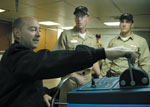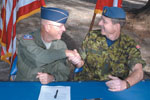Narcotics And Terrorism Are Linked, Pose Threats To Hemisphere
 |
| Adm. James Stavridis, USN (l), commander, U.S. Southern Command, was a keynote speaker at SOUTH 2008 in Miami. The admiral is concerned about semisubmersibles in the drug trade and their potential to accommodate terrorist activities. Here, Adm. Stavridis tries out the Navigation, Seamanship and Ship-handling Trainer aboard the USS Boone. |
The war on drugs has lost prominence in recent years to the war on terror, but the two dangers are not entirely separate. Leaders and other members of the anti-drug, anti-terror battles met in October to discuss the connections between illicit substances and insurgents and to emphasize the continued problem in the
Narcotics, their effects on society, the difficulty in stopping their proliferation and their link to terrorists were the focus of SOUTH 2008, a new AFCEA International event held in
Adm. James Stavridis, USN, commander of U.S. Southern Command (SOUTHCOM), which hosted the event in conjunction with AFCEA International, shared his perspective on the drug problem. The drug problem, he emphasized, is not in the
The admiral focused his speech on the problems posed by cocaine, which is produced almost exclusively in the Andes region of South America and makes it way to the
Perhaps the most serious effect is how cocaine and its smuggling relate to insurgents. “I believe there is a direct linkage between terrorism and narcotics,” Adm. Stavridis said. According to him, 300,000 people in the
The most recent version of the vessel has only four inches of structure above the water and nine feet below and can carry more than $200 million worth of cocaine in a single shipment. “If it can carry seven tons of cocaine, what else can you put in that semisubmersible?” he asked. Then he answered his own question by referencing weapons of mass destruction, but elaborated that no link between those weapons and semisubmersibles is in evidence today. However, he believes the
To counter the drug threat, nations and agencies must partner and cooperate to defeat the enemy. “Narcotics are an enormous challenge globally and in the
The key to defeating the supply aspect is to break into the chain and use it against itself. “It’s a brain-on-brain challenge,” the admiral said to the crowd, sharing that the enemy thinks about ways to improve smuggling every day, and these foes are clever and dedicated. Adm. Stavridis has a first-generation semisubmersible displayed outside SOUTHCOM’s headquarters to inspire personnel and visitors and to remind them of how the
 |
| Gen. Gene Renuart, USAF, commander, U.S. Northern Command, gave the first plenary address at SOUTH 2008, discussing the dangers drugs pose to the United States and all of the Americas. He stressed the importance of international and interagency cooperation in the counternarcotics fight. Pictured here, Gen. Renuart (l) signs a civil assistance plan with Lt. Gen. Marc Dumais, CF, commander of Canada Command. |
In other countries in the
Gen. Renuart echoed Adm. Stavridis’ call for greater interagency effort, explaining that groups must work together to interdict drugs in the maritime domain, referencing the semisubmersible threat, and added that tunnels are becoming a dilemma as well. In addition to cooperating with each other,
Lt. Gen. Glenn Spears, USAF, deputy commander, SOUTHCOM, remarked in his speech that, “The scourge of illegal drug trafficking … unfortunately is alive and flourishing in the
One of those other nations is
 |
| Lt. Gen. John Dubia, USA (Ret.) (l), executive vice president of AFCEA International, introduces the “How Do We Promote Public-Private Partnerships to Win the Counter Narco-Trafficking Fight?” panel at SOUTH 2008. Standing behind the table is panel moderator Vice Adm. Tim LaFleur, USN (Ret.), principal, Navy Marine Corps Market at Booz Allen Hamilton. The panelists are (l-r) Stephen Carmel, senior vice president of Maritime Services at Maersk Lines; Ambassador Charles Ford, business engagement adviser to the commander, Headquarters U.S. Southern Command, and former U.S. ambassador to Honduras; Nate Harrison, corporate vice president for security worldwide, UPS; and Rear Adm. Joseph Nimmich, USCG, director, Joint Interagency Task Force South. |
To combat those persons, the government in
SOUTH 2008 featured two additional speakers—Nicholas Negroponte, the chairman of One Laptop Per Child, who explained the work his nonprofit conducts to spread education and innovation to disadvantaged nations, and Vice Adm. Nancy Brown, USN, the director of command, control, communications and computer systems (J-6) on the Joint Staff. Adm. Brown did not discuss counternarcotics, but instead spoke about the Global Information Grid 2.0 and how it will put the warfighter at the center of communications. Relating it to SOUTHCOM’s work, she shared that network efforts underway will make sharing among services and other partners easier and more efficient. Adm. Brown also mentioned her goal to eliminate the Defense Messaging System and move to a more effective mode of information sharing.
In addition to the six speakers, SOUTH 2008 featured five panels focused on different elements of the counternarcotic effort. The first was “Narco-Trafficking: What is the Nexus with the War on Terror?” The moderator, Vice Adm. Brian Peterman, USCG (Ret.), kicked off the discussion by saying that while others are worried about overstating the possibility of drug trafficking methods being used to smuggle terrorists and their goods, “I don’t think it can be overplayed.”
Panelist Charles Allen, undersecretary for intelligence and analysis at the U.S. Department of Homeland Security (DHS), spoke about the danger of drugs and cartels. He said that the DHS is aware of the potential for terrorists to employ narcotics transport methods. However, the goal of cartels is to make money from the drug trade and that they do not want to provoke the
Allen disclosed that financial and recruiting operations for Islamic extremist groups are believed to be ongoing within the
Michael Braun, chief of operations, DEA, revealed a stronger link between terrorism and drugs than many at the conference. Of 43 foreign terrorist organizations, 19 are linked to the global drug trade, he said. Besides cartels that operate mainly in the
Braun also shared that drug trafficking organizations are more sophisticated than many terrorist groups and should be prevented from mingling with the insurgents anywhere on the globe. Governments should work as hard as possible to drug traffickers and terrorist groups apart “or we will all pay the price,” he concluded.
The final panel of the conference focused on the public-private partnerships necessary to defeat drug traffickers and potential terrorists. Representatives from Maersk Lines, a shipping company, and UPS shared how their companies are reporting oddities and anomalies to authorities who can then investigate. Stephen Carmel, the senior vice president of Maritime Services at Maersk, said employees on ships are like human intelligence collectors in the maritime domain, passing information at no cost to the government. Nate Harrison, the corporate vice president for security worldwide, UPS, said his company is providing information to law enforcement and could do more because of its tracking abilities, but certain actions require new legal protections. He also mentioned that UPS has a duty to respect and protect customers’ privacy and return profits to shareholders while contributing to national security.
The three other panels were titled “The Global Impact: Where is the Unity of Effort to Combat Transnational Threats?,” “How Do We Build Capacity for Joint and Combined Counter Narco-Trafficking Operations?” and “Narco-Trafficking Technology and Innovations: How Do We Counter Emerging Threats to National Security?” The final panel featured remarks on the importance of encouraging thoughts and new ideas to counter drug traffickers, as well as the need for experimentation with the understanding that some projects will fail.
Throughout the conference, many speakers and panelists touched on the same topics, including the lack of discussion of narcotics problems by candidates running for office, the threat posed by semisubmersibles and the need for increased and better partnerships. Several people at the podium highlighted JIATF South as a model of interagency and international cooperation.




Comments